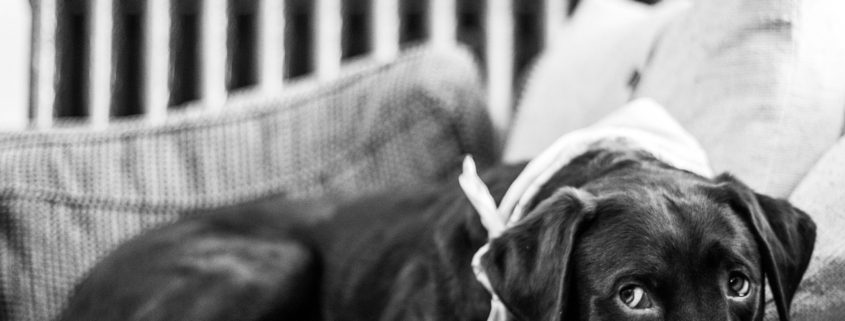Ask Crystal: New Dog Slow to Warm up

Dear Crystal,
We’ve just adopted rescue 3-year-old dog. We already had a year old Leonberger who has a lot of puppy energy. They got along and played fine at the rescue playground, but once brought home the new adopted dog stays on the couch for the most part and when our Leonberger tried to approach her she growls and sometimes barks, so that we are afraid she might bite our first dog. She seems very mellow and afraid, but our dog just wants to play and be a puppy. We are concerned if this is going to be a problem and dogs won’t get along. We are hoping it’s just temporary while the new dog settles down. Thank you for your help.
Sincerely,
Concerned Mom
Dear Concerned,
Congrats on the new addition and thanks so much for choosing to rescue! Tension between new doggie roommates can be pretty common, especially with adult dogs and dogs that have been rescues. Dogs that are more on the fearful side can often need more time to acclimate.
Puppies tend to be very dog social and just want to play with every dog. As dogs age they do naturally become more selective. That doesn’t mean that they can’t get along with other dogs necessarily. It can mean that they like certain personalities of other dogs to play with. It can also mean that they need longer introduction periods with more separation and intentional introductions. It could be that the new dog is a little intimidated by the size of your puppy. A year old Leonberger is a large dog and could be intimidating to some dogs at first.
Introductions at the shelter are good first step but definitely just a first step in the introduction. Things usually get more complicated when the dog comes into the home environment. There are so many variables that effect how the dogs will get along in a particular home. I have seen plenty of dogs that go from one home where they may not have the best relationship with the other dog to another where they have a great relationship. It can vary on the personalities of the two dogs, how we introduce them and how we live our day to day lives.
Stress Factors
When a dog loses their home for whatever reason, they experience a lot of stress. And even the newest, nicest animal shelter is a very stressful place for a dog. When stressors, both negative and positive, build up it causes something we refer to as trigger stacking. Trigger stacking means that the response to a trigger will often happen more quickly, and the dog will have a stronger reaction than they normally would if they were not stressed out. Think back to the most stressful time in your life, I bet during that time you found yourself overreacting to things and probably a lot more easily than normal.
When a dog first comes home, we should provide it with its own space that it can retreat to. In the beginning, stick to introductions while outside only and inside the house separate the dogs with some sort of barrier depending on the situation. Ideally, one dog would be behind a door. Sometimes the new dog is not crate trained and can’t be left in a room alone. If your first dog is crate trained, you may be able to put him in a room and let the new dog have time out and then switch them periodically. Having the dog behind a barrier and not having to see the other dog, allows them time to get used to the smell of the other dog without the stress of a face-to-face meeting.
 When dogs are fearful, they are often what we refer to as “shut down”. This is a behavioral safety measure where the dog simply does not make many if any choices and inhibits their normal behavior. They usually will seem much calmer and move a lot less. They may not eat, sleep or go to the bathroom normally. Dogs can also have the opposite reaction and become more animated. It sounds like if she isn’t moving much, she may be shut down which also indicates a high level of stress.
When dogs are fearful, they are often what we refer to as “shut down”. This is a behavioral safety measure where the dog simply does not make many if any choices and inhibits their normal behavior. They usually will seem much calmer and move a lot less. They may not eat, sleep or go to the bathroom normally. Dogs can also have the opposite reaction and become more animated. It sounds like if she isn’t moving much, she may be shut down which also indicates a high level of stress.
Dog Introductions
We usually wait for the new dog to be behaving in a normal way before proceeding with face-to-face introductions. It is critical for her to feel safe in the new environment before expecting her to meet new animals. We can usually tell that they are starting to feel better if they are moving around, playing, eating, drinking and going to the bathroom normally.
Provide low stress, non-confrontational ways for the dogs to interact outside so they can start to get more comfortable with each other. Make sure each dog is tired before these meetings. Maybe take the puppy out for a good play session before hand.
Tandem walks are the best way to achieve this. Take a walk together on a quiet street or maybe in a large field. Start walking on opposite sides but going in the same direction. Slowly decrease the distance between the two dogs as long as they are being calm and friendly. If the dog looks at the other dog calmly, feed him a treat. We are looking for the dogs to be able to walk calmly but also divide their attention between you and the other dog. If the dog is hyper focused on the other dog and unable to focus on you, get more distance between you. Keep closing the distance until the humans are on the inside and both dogs are walking calmly on each side. We can now briefly let the dogs greet each other as long at the body language is loose and soft and not stiff. Anytime their bodies get stiff, calmly get them moving again.
Inside the house, a good next step is sessions of allowing visual access while one dog is behind a baby gate. Have the other dog on a leash and walk him as close as you can up to the other dog without either dog barking or growling. If there is aggressive behavior, that just means that the dogs need more space so back up until you get to a distance where the dogs are not reacting. Every time the dogs look at each other calmly feed them a high value treat like chicken. Do short 5-minute sessions throughout the day and then close the door again. Combine this with a daily tandem walk.
When a dog is growling and/or barking they are trying to communicate a need for space. It is actually pretty common that a new dog laying in their own space would be uncomfortable by being approached. We refer to this as a correction. A correction is a way a dog communicates to another dog that he needs to change what he is doing. A correction is normal, healthy communication and should not be interrupted or punished. There are dogs that move too quickly up the levels and that is where we start to get concerned. The other concern is when the receiver does not change their behavior or reacts aggressively to the correction.
Normal low-level corrections are turning away, lip licking, change in mouth status, whale eye. Next level would be freeze, lip lift, soft growl, hard stare. Then if the dog is still not being listened to they may air snap, low growl, bark or muzzle punch. A bite is really the last level of corrections so a normal dog should be escalating up the scale which means you should have time to intervene. If you and the puppy ignore all the previous correction levels, that is when a bite can be forthcoming.
Watch how your puppy responds to the growling or barking. We want to see that he understands that the other dog needs space. Some signs you might see would be him turning his head away, licking his lips, yawning and walking away. If he continues to try to walk into her space, then you need to be stepping in to prevent that. You can try to verbally correctly him by calmly telling him to leave it or use a leash to remove him. We don’t want to be yelling loudly as that will increase the tension.
It’s a good idea in the beginning of having a newly adopted dog to let them drag a leash around the house for a variety of reasons. If you need to separate the dogs to prevent escalation, it is the safest way to do that.
When the dogs are in a shared space like a living room, consider having a leash on one or both of them and having them on opposite sides of the room. You can hold onto the leash or attach it to a door or piece of furniture and put a comfy bed nearby. Feed the dogs treats for calm behavior when they look at the other dog.
Some additional tips for a smooth introduction are pick up any toys, treats, bones and high value items off the floor. Avoid high arousal games like tug and fetch until they are bonded. You may want to avoid petting the dogs right next to each other. Feed the dogs any food or treats in separate areas. Avoid feeding treats right next to each other. Give any high value items likes chews or kongs while the dogs are in separate areas or crates. Supervise interactions in the home and give them breaks by switching them out in crates or rooms or taking for individual walks. Try to reduce any areas of stress and tension that you can.
Dog Body Language
Understanding dog body language is very important to intervene and prevent potential issues. Study up on dog body language before attempting any introductions. Pay attention to the overall body posture and look for soft, curvy bodies, open mouth panting, and movement. A tail wag is not always friendly especially if the tail is held high over the back and stiffly wagging. Videos on dog body language can be found here.
 It is important to be able to recognize the difference between heathy and unhealthy play. Unhealthy play should be interrupted frequently and supervised. We can teach dogs to learn to interrupt their own play by interrupting and allowing the dogs to calm down before interacting. We can also identify rude play that may lead to a correction from the other dog. Some examples of healthy play include play bows especially if the dogs are unfamiliar, pauses, exaggerated movements, open mouths, low loose tails, self-handicapping, emotional control, bite inhibition, role reversal is not required.
It is important to be able to recognize the difference between heathy and unhealthy play. Unhealthy play should be interrupted frequently and supervised. We can teach dogs to learn to interrupt their own play by interrupting and allowing the dogs to calm down before interacting. We can also identify rude play that may lead to a correction from the other dog. Some examples of healthy play include play bows especially if the dogs are unfamiliar, pauses, exaggerated movements, open mouths, low loose tails, self-handicapping, emotional control, bite inhibition, role reversal is not required.
Some examples of play which is concerning and should be frequently interrupted: little or no pausing, little or no self-handicapping, increased arousal, one dog attempts to terminate play, one dog dominates the actions of the other or restrictions freedom of movement, bully behavior, blood. Supervising and separating when the dog is unable to will help prevent the other dog from feeling afraid or bullied.
The final steps on integration should begin when the dogs show relaxed posturing at all times around the other dog. In the final stages, you can let the dogs drag leashes around the house so that you can easily separate. The final step is taking the leashes off and allow free access to the other dog. The speed this takes will depend on the dog, but the dogs should be happy and relaxed before progressing to the next step at every stage. Separate the dogs when unsupervised for safety. There may come a point after several months or longer with no incidents that you feel safe leaving them together alone or you may separate them while unsupervised for the rest of their lives. Preventing any incidents is the most important priority to keep in mind.
It sounds like the best thing for you to do is start over with your introductions and to give it the time it needs. That doesn’t guarantee that the two dogs will get along in the end but there will be a much better chance of it if you give her the space she is asking for. Good luck!
Until next time,
Crystal
Submit your own pet behavior question for Crystal here:







